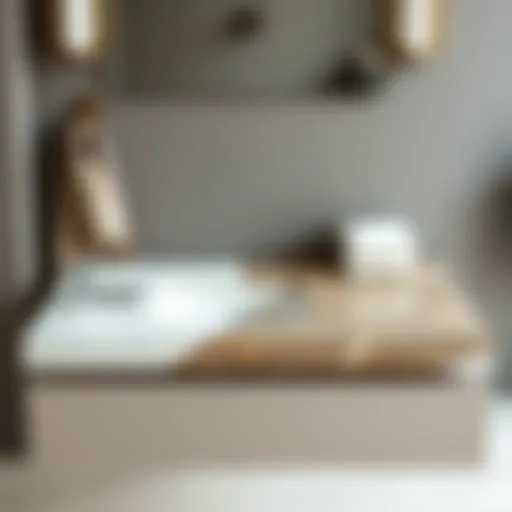Expert Techniques for Hanging Pictures in Your Home
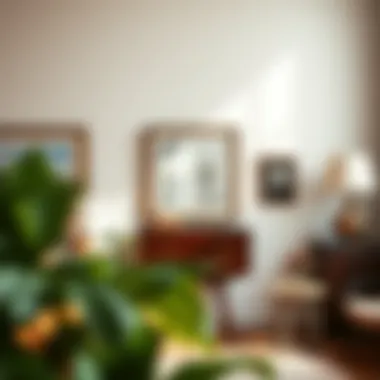

Intro
Hanging pictures seems straightforward, right? You just grab a hammer, a nail, and your favorite artwork, and voilà! However, achieving a display that truly enhances your space goes beyond mere instinct. This guide aims to delve into the nitty-gritty of hanging pictures, from understanding the different types of hardware and tools to offering advice on layout and arrangement. Especially for those who appreciate art, striking a balance between form and function is key. Whether you’re a homeowner looking to inject personality into your living room, or a realtor seeking to showcase a property, knowing how to hang pictures properly can be a game changer.
Understanding that each piece of art tells a story, taking the time to execute a proper display can elevate the narrative of your space. But before diving into hammering and hanging, it’s worth considering the factors that will affect not just the installation, but the visual impact as well.
Key components include:
- The wall itself: Different materials call for different tools and techniques.
- The artwork: Is it heavy or light? Fragile or durable?
- The aesthetic goal: Are you going for a structured gallery wall or a more casual display?
- The audience: Who is going to see this artwork? Tailoring your approach to the viewer can make a big difference.
By unraveling these elements, we’ll together create not just a guide on tools and techniques for hanging pictures, but a pathway to transforming spaces through stunning art displays. So, let’s roll up those sleeves and get to work!
Foreword to Hanging Pictures
Hanging pictures seems simple, but it's more than just putting a nail in the wall and slapping on a frame. Understanding the methods and tools you use can maximize both beauty and function in your space. This guide goes beyond the basics—it's about making informed decisions1. It’s an extension of your personality and style, telling a story for anyone who walks through your door. Effective picture hanging can turn a plain wall into a vibrant gallery that resonates with your style and preferences.
The Significance of Picture Hanging
The act of hanging pictures is not merely a task of home improvement; it's a meaningful endeavor that enhances the way we experience our surroundings. When you think about it, the artwork you choose to display effectively communicates your interests, tastes, and personal history. Selecting the right pieces and arranging them thoughtfully impacts not only the aesthetics of your space but can also influence your mood and emotions.
Picture hanging has a few significant roles:
- Creating Visual Interest: Art attracts attention and can make even a bare room feel alive.
- Enhancing Design: When done right, artwork functions as a focal point, drawing visitors’ eyes and enhancing the overall design theme.
- Expressing Yourself: Each piece is like a chapter in a book, offering insights into your personality or the story of your life.
For these reasons, it’s essential to approach this seemingly simple task with careful consideration.
Visual Impact of Art in Home Design
Art has a profound influence on home design that can transform an ordinary space into something extraordinary. Think of it like seasoning in cooking—just a dash can elevate a dish from mundane to magnificent. Well-placed art brings color, texture, and emotion to our walls and, by extension, our homes.
- Color Schemes: Artwork can tie together disparate colors in a room, serving as a visual bridge that connects various design elements.
- Mood Setting: The right piece can evoke feelings of calm, excitement, or nostalgia, allowing you to set the mood in any area of your home.
- Conversation Starters: A captivating piece often invites discussion, providing a point of connection among family and friends.
Ultimately, art adds depth, warmth, and character. People don’t just look at pictures; they feel them. You could say it's like giving a heart to your home, fostering connections and stories that resonate with those who enter.
"Art enables us to find ourselves and lose ourselves at the same time." — Thomas Merton
In summary, understanding the significance of picture hanging and the visual impact of art in home design is crucial for both aesthetic allure and personal expression. As you move forward with this guide, you will gain insights into essential techniques and tools for hanging your favorite pieces, ensuring your walls tell a story that’s uniquely yours.
Types of Hardware for Hanging Pictures
Hanging pictures is not just about finding a nail and hammering it into the wall; it's a delicate art that involves selecting the right hardware for your specific needs. The type of hardware you choose can greatly influence the durability and appearance of your artwork display. Each piece of hardware serves a different purpose, considering the weight of the artwork, the type of wall, and the aesthetic you want to create. Understanding these options is key to ensuring your beloved pieces don’t come crashing down unexpectedly and that they look their best.
Nails and Hooks
Standard Picture Hangers
Standard picture hangers are often the first choice for homeowners looking to put up artwork without breaking the bank. These small, affordable hooks come with a nail that can easily penetrate drywall. They can support weights typically up to 20 pounds, making them suitable for most framed pictures.
What makes standard picture hangers standout is their ease of use. You just need a hammer, a steady hand, and you're good to go. However, the downside is that they may not be ideal for heavier artwork. If you’re hanging something particularly weighty, this type may not cut it, and that could lead to disaster. Nevertheless, for lighter pieces, they’re a dependable choice.
Sawtooth Hangers
Sawtooth hangers are another favorite, especially among artists and decorators. They are typically found on the back of a frame and provide a simple solution to hanging art securely. The zigzag design gets its name from the tooth-like shape, which allows for easy adjustment once the artwork is on the wall.
A significant advantage of sawtooth hangers is the ability to easily reposition the artwork, allowing you to achieve perfect leveling with minimal hassle. However, they usually require multiple nails due to their design, which can be a drawback—especially if you are planning on frequently rearranging your pictures.
Wall Anchors and Screws
Expansion Anchors
When it comes to heavier pieces or artwork mounted on plaster or concrete walls, expansion anchors are a must-have. These anchors expand once installed, creating a tight fit that significantly enhances holding power. With a range of sizes, they cater to different weights, which can make all the difference.
The simplicity of installation and their robust weight capacity make expansion anchors a popular choice. But, installing them usually requires pre-drilling a hole, which might not be everyone's cup of tea. Still, for anyone looking to hang substantial artwork confidently, these are invaluable tools.
Toggle Bolts
If you’re dealing with a particularly heavy frame or a hollow wall, toggle bolts come into play. They provide a strong grip due to their winged design, which locks into place behind the wall once you've inserted them. This way, you don’t have to worry about the weight causing any damage.
Toggle bolts can be a bit tricky to install as they require a larger hole than traditional screws. But the peace of mind they offer when hanging your prized art pieces is worth the effort. Just ensure you select the right size for your artwork, as improper sizing can lead to complications.
Adhesive Solutions
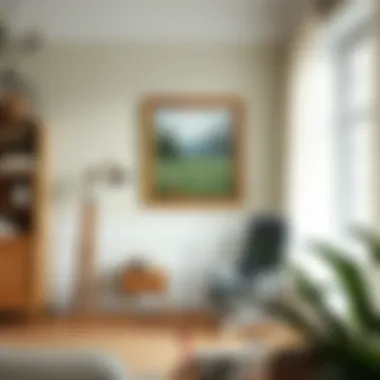

Command Strips
Command Strips revolutionized the way we hang art. They are an excellent choice for renters or those who frequently change their decor. These adhesive strips stick firmly to the wall and the artwork without damaging the surface when removed. You simply stick them on, press them together, and voilà!
The convenience of Command Strips is hard to beat; however, they have limitations regarding weight. If your artwork is particularly large or heavy, you may have to use several strips, which might not be feasible. Still, for lighter frames, they’re a blissful way to add decorative flair without drilling.
Double-Sided Tape
Double-sided tape is a crafty, though less conventional, method for hanging pictures. It offers a quick and neat way to adhere frames directly to the wall. While convenient, it’s worth noting that it may not hold up heavy frames and can leave a sticky residue on the wall if not removed carefully.
It’s the ideal choice for photos or smaller canvas prints where permanence isn’t a major concern. Consequently, if you're deliberating more temporary arrangements, double-sided tape might just be your best friend.
Picture Rails and Ledges
Traditional Picture Rails
Traditional picture rails are a nod to classic interior design, allowing artwork to be hung without touching the wall itself. They provide an elegant way to display art while making rearrangement a breeze. With a simple picture wire or cord, you can change the art as often as you like without worrying about holes in the wall.
Although they might require some installation initially, the benefit is significant for those who favor switching displays frequently. That said, traditional picture rails may not suit all modern aesthetics, so one should consider the overall design scheme of the room before opting for this method.
Floating Shelves
Floating shelves have gained popularity for their versatility and chic appearance. They allow you to display not just art but also books, plants, and various decorative items in a cohesive arrangement. The shelves can be installed at any height, giving you control over your display.
One downside is the need for proper installation to ensure stability. Improperly installed shelves can lead to a precarious experience. However, when done right, floating shelves can transform a plain wall into an eye-catching display area, merging functionality with aesthetics.
In the end, understanding the various types of hardware is fundamental to achieving an ideal presentation of your artwork while ensuring its safety. Selecting the right piece may make all the difference in transforming your home into a gallery of your liking.
Essential Tools for Picture Hanging
When it comes to hanging pictures, having the right tools can make a world of difference. These tools not only ensure that your artwork is displayed securely but also help to achieve the precise arrangement you desire. Using the correct instruments can save you time, effort, and frustrations along the way. From measuring to marking and drilling, here’s a detailed overview of the essential tools you’ll need.
Measuring Tools
Tape Measure
A tape measure is arguably one of the most crucial tools for hanging pictures. It enables you to take accurate measurements of both the wall space and the artwork itself, ensuring your frames will fit where you want them. This tool is flexible, making it easy to measure in tight spaces and awkward angles. A common characteristic of a tape measure is its retractable design, which makes it convenient to store and carry.
One unique feature that many modern tape measures have is a locking mechanism. This function secures the tape at the desired length, allowing you to take measurements without the need for extra hands. The main advantage here is that it provides stability while measuring—it’s just you and the wall, no acrobatics required. On the flip side, one must be careful not to let the tape retract too quickly, as it can snap back and cause accidental injuries.
Level
A level is another indispensable tool in your hanging arsenal. It ensures that your pictures are hung straight and aligned, which is especially important for larger pieces or gallery wall displays. The essential characteristic of a level is its ability to indicate the horizontal alignment through the use of a bubble indicator.
Having a level handy takes the guesswork out of hanging. It helps you avoid that uneasy situation where you step back to admire your work only to find a crooked frame staring back at you. The unique feature of pocket-sized levels makes them both accessible and user-friendly. However, be mindful when using it on uneven surfaces; adjustments may be necessary to achieve the right alignment.
Marking Instruments
Pencil
A pencil is, without question, one of the simplest yet most effective marking tools available. It allows you to make overhead marks directly on the wall where you plan to place your picture. The fine point ensures precision, which means small adjustments are easier to make without making a big mess.
One significant advantage of using a pencil is that it can be easily erased or painted over if you happen to change your mind. This flexibility is ideal, especially for those who like to experiment with their layouts. However, a downside is that pencil marks can sometimes be hard to see on certain wall colors, so it might require a good ol’ squint or repositioning to find them.
Chalk Line
The chalk line is another tool that comes in handy for creating straight lines over larger sections of wall space. This instrument consists of a string coated in chalk that, when snapped against a surface, leaves a straight line. This simple mechanism allows for quick, accurate markings across wide areas.
Using a chalk line is especially useful for gallery walls where you might want multiple pieces aligned perfectly. The primary advantage of this tool is that it gives you a visual guideline to follow, which is invaluable for achieving an organized look. However, a chalk line can sometimes create dust, and the marks may not always wash off easily. Therefore, it’s wise to be cautious when marking delicate or textured surfaces.
Drills and Drivers
Cordless Drill
A cordless drill is a powerhouse tool for any home improvement project, including picture hanging. With its portability and ease of use, it allows for the quick installation of hardware like screws and wall anchors, making it a time-saver in any picture hanging endeavor. The standout feature of cordless drills is their rechargeable battery, which gives you freedom to move around without getting tangled in cords.
This versatility makes cordless drills immensely popular; they can tackle various tasks beyond just hanging pictures. While they provide significant advantages in time and ease, users need to pay attention to battery life. Running out of charge mid-project can slow things down and lead to potential frustrations.
Screwdriver
A screwdriver may seem basic, but its role in picture hanging should not be underestimated. Whether you're using it to secure a screw into the wall or tighten hardware on the back of a frame, a reliable screwdriver is essential. In contrast to electric tools, a manual screwdriver offers better control, particularly in tight spaces.
One notable feature of modern screwdrivers is that they come with interchangeable heads. This allows for versatility across different types of screws. The advantage of using a screwdriver is that it enables you to apply an appropriate amount of pressure without risking damage to your wall or artwork. Nevertheless, the downside is that it can be labor-intensive if you have to drive multiple screws into harder materials.
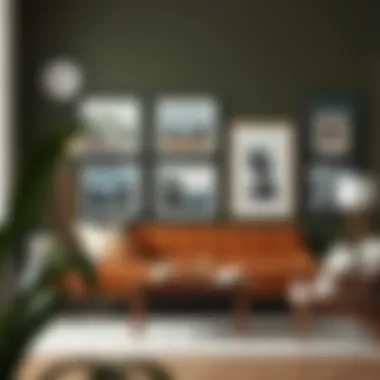

Safety Equipment
Safety Glasses
When handling tools and performing any work at height, safety glasses should be part of your toolkit. Protective eyewear safeguards your eyes from dust, debris, and any potential injuries that may occur during drilling. This important piece of safety gear is a staple that every DIY enthusiast should have.
The primary benefit of wearing safety glasses is crystal clear: protection. Most of them are lightweight and comfortable to wear, allowing for extended use without discomfort. However, they can fog up under high-temperature or humid conditions, which can be a small annoyance when you're trying to get the job done efficiently.
Work Gloves
A good pair of work gloves rounds out your safety gear. They protect your hands from rough surfaces and sharp edges while handling picture frames or tools. They typically come in various materials, with some offering additional grip for better control during more delicate tasks.
The advantage of wearing work gloves is that they can prevent scrapes and cuts, saving you a visit to the first-aid kit. However, the trade-off is that some gloves can reduce tactile sensitivity—there’s a balance between protection and the finesse necessary for precise jobs.
Considerations Before Hanging Pictures
Hanging pictures might seem like a straightforward task; however, there are several important considerations that can significantly influence the outcome of your display. Understanding these considerations helps in selecting the right hardware, protecting your walls, and ensuring that the finished look matches your vision. It's about finding that sweet spot where functionality meets aesthetics. By taking into account factors such as the weight of the artwork, the wall material, and room lighting, you can create a gallery that doesn't just hang on the wall but also resonates with the overall theme of your space.
Weight of the Artwork
One of the first things to consider when hanging any piece of artwork is its weight. Heavy pieces require different hardware than lighter ones. You don't want a precious painting crashing to the floor simply because you used insufficient supports. In most cases, if an artwork feels substantial in your hands, it probably warrants special attention. For instance, a painting weighing more than 10 pounds should typically be hung using heavy-duty wall anchors or screws rather than standard hooks.
Not only does this guarantee the safety of your artwork, but it also keeps your wall looking pristine without unnecessary damage. When in doubt, it's wiser to err on the side of caution and choose the more robust options for hanging.
Wall Material
The wall your artwork hangs on greatly influences how you should anchor your hardware. The characteristics of different wall materials can change the game completely.
Drywall
Drywall is the most common wall material found in homes. Its lightweight nature makes it an appealing choice for artwork. However, it lacks in durability. The key characteristic of drywall is its susceptibility to damage under heavy weight. Using specific hardware like drywall anchors allows you to distribute weight effectively. Hidden behind the sheetrock, they offer a solution for sturdier installations while minimizing wall damage. On the downside, you may need to use a stud finder to avoid relying solely on anchors, which can only hold so much weight, generally around 15-20 pounds.
Concrete
On the other hand, concrete presents a different set of challenges and advantages. It’s durable and can support considerable weight, which makes it ideal for larger artworks. However, drilling into concrete requires specialized equipment, such as a masonry drill bit. Another downside is that it can be more difficult to reposition your art without causing more damage to the wall itself. Should you choose concrete, well-suited anchors like toggle bolts can provide a secure hold.
Brick
Brick walls evoke a certain charm and character that can enhance the display of artwork. Like concrete, brick is highly durable, allowing large paintings or heavy frames to hang securely. The unique feature here is its texture; it offers a rustic aesthetic that some might find appealing. However, just like concrete, the need for specialized tools like a masonry drill is a drawback. Always ensure that you are drilling into the mortar joints rather than the brick itself, as this will silence any worries about structural integrity and also allows for easier reinforcements.
Room Lighting and Placement
Lastly, you need to consider how room lighting affects the visual impact of your artwork. Natural light plays a massive role in how the colors and textures are perceived. Positioning artwork too close to windows may lead to sunlight damage over time, fading those captivating colors.
Additionally, artificial lighting from lamps and fixtures should be considered for creating ambiance. Think about where you want the eyes to linger within the room. Perhaps framing artwork at eye level or angling it in a specific direction can help.
By paying attention to these details, you ensure your artwork not only complements your decor but also thrives in its environment. In summary, carefully evaluating the weight of your pieces, the wall material they're hanging on, and the surrounding light ensures your final display will be both functional and visually stunning.
"The right consideration can elevate your art from mere hanging decor to a centerpiece that captures attention and admiration."
Techniques for Arranging Art
Arranging art effectively is both an art and a science. The right arrangement can transform a mundane wall into a captivating focal point. Understanding the various techniques available allows you to express your personal style while also catering to the spatial dynamics of a room. The goal is not just to hang art but to curate a visual narrative that enhances the overall ambiance of your home. Think of it like assembling a puzzle; every piece needs to fit seamlessly to create a complete picture.
The Grid Method
The grid method is one of the most systematic approaches for arranging art. With this technique, artworks are aligned in a clean, organized manner, creating a structured visual display. To implement this method:
- Choose a Theme: This could be color schemes, subject matter, or frame style. Consistency in these elements ties the gallery together.
- Measure and Mark: Use a measuring tape and pencil to outline the grid layout on your wall. Ensure equal spacing between pieces to maintain a polished look.
- Hang with Precision: Start from the center of your grid. This provides a solid anchor point, ensuring that all pieces align uniformly.
The grid method is particularly suited for minimalistic styles and environments where order reigns supreme. It’s ideal for modern settings or when displaying a series of photographs from a specific project. However, this approach might not resonate with those who prefer more spontaneous or eclectic arrangements.
Salon Style Arrangement
Salon style, alternatively known as a gallery wall, embodies a more free-spirited approach towards displaying artwork. This technique allows various pieces, regardless of size or frame style, to coexist harmoniously on the same wall. To master salon style:
- Mix and Match: Gather a variety of artworks, mixing smaller pieces with larger ones and varying the frame styles. The key is to allow your artistic voice to shine through.
- Create Layers: Start with the larger pieces as anchors, and build layers with smaller items around them. This layering creates depth and visual interest.
- Eye-level Display: Position the art at eye level for optimal viewing. This not only makes the pieces more engaging but also invites viewers to interact with the arrangement.
Salon style arrangements are perfect for those who appreciate an eclectic aesthetic or wish to showcase a diverse collection, making them an excellent choice in more personalized living spaces.
Centering and Spacing
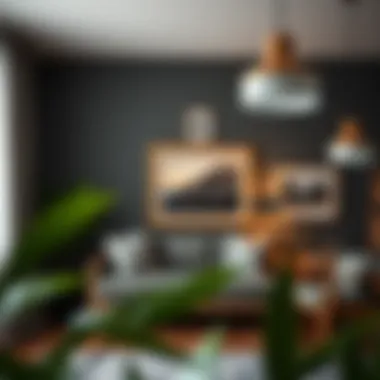

Centering and spacing involves a more classical approach, focusing on symmetry and balance. In this technique, pieces are often displayed with a central anchor that draws attention, helping to create a refined visual feel. Here’s how to achieve it:
- Select a Focal Point: Choose a standout piece to serve as the centerpiece. This could be a large painting or an exquisite sculpture.
- Establish Balance: Arrange surrounding pieces with equal visual weight. This may require adjusting sizes and colors to ensure harmony.
- Consistent Spacing: Maintain uniform gaps between pieces. This could be anywhere from two to five inches, depending on the size and style of artwork.
By centering and spacing artworks, you create a sense of order that many find appealing. This method works remarkably well in formal settings, where a touch of elegance is desired, such as dining rooms or living spaces.
Remember, the ultimate goal is to create a space that reflects your own aesthetic. Whether you favor a strict grid, a lively salon style arrangement, or an elegant centered display, these techniques empower you to showcase your art beautifully.
Displaying Different Types of Artwork
Displaying different types of artwork is pivotal to creating an inviting atmosphere that reflects personal style and creativity. The collection you curate narrates a story about who you are, blending colors, textures, and styles that resonate with your daily life. Understanding how to hang and present various forms of art not only enhances the aesthetic appeal of a space but also contributes to its overall vibe. Here, we delve into framed pictures, canvas prints, and three-dimensional pieces, discussing how each one can uniquely impact your decor.
Framed Pictures
Framed pictures serve as a quintessential element in art display. With countless styles of frames available, they provide a perfect way to protect and accentuate the artwork. The frame itself often dictates the tone of the display—be it modern, classic, or rustic.
Considerations for displaying framed pictures include:
- Choosing the right frame: A mismatched frame can easily turn a stunning piece into a mere afterthought. Taking the time to select frames that harmonize with the artwork and surrounding decor is key.
- Placement height: Ideally, the center of the artwork should be at eye level. A good rule of thumb is to place it approximately 57 to 60 inches from the floor. This enhances visual accessibility and appeal.
- Grouping styles: When showcasing a series of framed pictures, consider varying the sizes for an eclectic look or maintaining uniformity for a polished feel.
"Art speaks where words are unable to explain. A well-framed piece can encapsulate feelings often left unsaid."
Canvas Prints
Unlike traditional framed artwork, canvas prints offer a more casual aesthetic while maintaining a modern touch. Canvas can be stretched and wrapped around frames, creating a clean and uninterrupted look that works wonder in contemporary spaces.
Key aspects to note about canvas prints:
- Material quality: The acrylic or oil used plays a large role in the visual outcome. High-quality inks enhance colors and reduce fading.
- Hanging methods: Depending on the format, canvas prints can be hung using a staple method or on a floating frame. This can dramatically influence the perceived depth and structure of your display.
- Layering: Combining various canvas sizes creates a dynamic display. Larger pieces can serve as focal points with smaller ones complementing or contrasting around them to create a cohesive gallery.
3D Objects and Sculptures
Incorporating three-dimensional artwork such as sculptures or other unique objects injects life into a room. These pieces offer texture and a tactile experience that framed art often can't.
When it comes to displaying 3D objects, consider the following:
- Shelf placement: Ensuring they are placed on shelves or in shadow boxes allows for safe exhibition while maximizing visibility.
- Creating focal points: Sculptures can direct attention toward a particular area in the room, acting as conversation starters.
- Materials and finishes: Consider the overall style of the home. A brass sculpture may not blend well in a farmhouse aesthetic while complementing a modern or industrial design impeccably.
Maintaining Your Wall Displays
Hanging pictures is only the beginning of creating a visually appealing space. Once your artwork is on the walls, maintaining those displays becomes key to their lasting beauty and effectiveness. Keeping your wall displays in top shape not only enhances the visual impact of your art but also preserves its condition and extends its life. Regular attention to your collections reflects a sense of care and attention that impresses guests and contributes to a harmonious living environment.
Cleaning Artwork
Maintaining your wall displays requires conscientious cleaning of the artwork. Dust and grime can gather on surfaces, diminishing the colors and potentially harming the media. How can you keep your pictures looking sharp? Here are some methods:
- Soft Brushes: A gentle, soft-bristled brush is ideal for cleaning frames and glass. It helps sweep away dust without scratching surfaces.
- Microfiber Cloths: These are excellent for wiping down glass and finished surfaces. Always use them dry or slightly damp, but avoid lots of moisture to prevent damage.
- Art-Safe Cleaners: If your artwork is especially dirty, consider using a cleaner that is safe for art materials. It's crucial to avoid regular cleaning substances, as these might react poorly.
"A well-maintained piece of art tells a story not just with its visuals but also with the care it has received over time."
It’s useful to create a routine, perhaps set a reminder every few months to give your artwork a little TLC. This keeps things fresh and suitable for any changes in seasons or lighting.
Rearranging for Freshness
After spending time arranging and hanging your art, you might wonder how long that arrangement should stay in place. Keeping a fresh look is essential for sustaining interest in your wall displays. Every so often, consider rearranging the artwork to bring new life into your space. Here are a few tips to consider:
- Seasonal Changes: Swap out pieces based on the season. Lighter, sunnier compositions can brighten your space in spring and summer, while warmer, moodier art can provide comfort in the colder months.
- Color Rotations: Consider changing artwork based on the color palette of your current decor or seasonal decorations. This not only keeps displays vibrant but also enables a dynamic interaction with your interior design.
- Storytelling: Rearrangement can help emphasize themes or stories you want to share. Rotating art can help convey different emotions or narratives as you shift the focus from one piece to another.
When you rearrange, take a step back and examine the overall composition. Ensure pieces harmonize and create a cohesive look. Making these adjustments keeps your environment engaging and reflects a thoughtful approach to interior design.
Art doesn’t just have to hang there; it should breathe, evolve, and inspire—even in its placement. Taking time to both clean and rearrange ensures your wall displays not only look fantastic but also resonate with freshness and intention.
Ending
Hanging pictures is more than just a task—it's an essential component of interior design that impacts the ambiance and feel of a space. The importance of this art lies in its ability to transform blank walls into vibrant canvases that reflect personal taste, historical context, and emotional significance. A thoughtfully arranged collection of pictures can enhance the structural features of a room and serve as focal points that draw admiration.
Summary of Key Points
Throughout this guide, several key ideas were discussed:
- Understanding the Basics: The choice of hardware is pivotal. Different items such as nails, hooks, or more specialized anchors cater to varied weight loads and wall types, affecting how securely your artwork can be displayed.
- Essential Tools: Equipment like a level and measuring tape may seem small, but they play a major role in executing a professional look. The devil is in the details; precise measurements help ensure that everything is hung straight and true.
- Considerations for Success: Factors such as the weight of the artwork and the material of the wall directly influence what methods to use. It's crucial to plan systematically.
- Techniques for Arrangement: Various styles like grid or salon-style apply creative principles that make the artworks speak to one another, fostering a harmonious display.
- Maintenance: Keeping an eye on your arrangements and cleaning the pieces can breathe new life into your space over time, offering fresh perspectives on the artwork you may have grown too accustomed to.
Inspiration for Future Projects
As you reflect on your own space, consider the evolving narrative of your collections. Perhaps your next project could involve creating a seasonal showcase—switching out artwork for different times of the year. Or even arranging a set of family photographs in a timeline format to visually narrate your family’s journey through time.
Also, explore the concept of thematic displays: curate pieces around a central idea—this could be color schemes, a travel log, or even a showcase of local artists. Engaging with art in such ways not only enhances your surroundings but also provides customary conversation starters for guests.
Ultimately, the realm of picture hanging offers no shortage of possibilities. Find what resonates with you, take the plunge, and let your walls tell a story that is uniquely yours. For further reading on display techniques and trends, websites like Wikipedia and community platforms, such as Reddit, are rich resources that can ignite your creativity.

